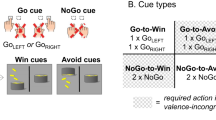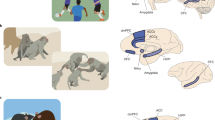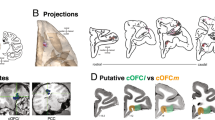Abstract
Two ideas have dominated neuropsychology concerning the orbitofrontal cortex (OFC). One holds that OFC regulates emotion and enhances behavioral flexibility through inhibitory control. The other ascribes to OFC a role in updating valuations on the basis of current motivational states. Neuroimaging, neurophysiological and clinical observations are consistent with either or both hypotheses. Although these hypotheses are compatible in principle, we present results supporting the latter view of OFC function and arguing against the former. We found that excitotoxic, fiber-sparing lesions confined to OFC in monkeys did not alter either behavioral flexibility, as measured by object reversal learning, or emotion regulation, as assessed by fear of snakes. A follow-up experiment indicated that a previously reported loss of inhibitory control resulted from damage to nearby fiber tracts and not from OFC dysfunction. Thus, OFC has a more specialized role in reward-guided behavior and emotion than has been thought, a function that includes value updating.
This is a preview of subscription content, access via your institution
Access options
Subscribe to this journal
Receive 12 print issues and online access
$209.00 per year
only $17.42 per issue
Buy this article
- Purchase on Springer Link
- Instant access to full article PDF
Prices may be subject to local taxes which are calculated during checkout





Similar content being viewed by others
References
Bechara, A., Damasio, H. & Damasio, A.R. Emotion, decision making and the orbitofrontal cortex. Cereb. Cortex 10, 295–307 (2000).
Davidson, R.J., Putnam, K.M. & Larson, C.L. Dysfunction in the neural circuitry of emotion regulation—a possible prelude to violence. Science 289, 591–594 (2000).
Saver, J.L. & Damasio, A.R. Preserved access and processing of social knowledge in a patient with acquired sociopathy due to ventromedial frontal damage. Neuropsychologia 29, 1241–1249 (1991).
Izquierdo, A., Suda, R.K. & Murray, E.A. Comparison of the effects of bilateral orbital prefrontal cortex lesions and amygdala lesions on emotional responses in rhesus monkeys. J. Neurosci. 25, 8534–8542 (2005).
Murray, E.A., O'Doherty, J.P. & Schoenbaum, G. What we know and do not know about the functions of the orbitofrontal cortex after 20 years of cross-species studies. J. Neurosci. 27, 8166–8169 (2007).
Hornak, J. et al. Reward-related reversal learning after surgical excisions in orbito-frontal or dorsolateral prefrontal cortex in humans. J. Cogn. Neurosci. 16, 463–478 (2004).
Fellows, L.K. & Farah, M.J. Ventromedial frontal cortex mediates affective shifting in humans: evidence from a reversal learning paradigm. Brain 126, 1830–1837 (2003).
Butter, C.M. Perseveration in extinction and in discrimination reversal tasks following selective frontal ablations in Macaca mulatta. Physiol. Behav. 4, 163–171 (1969).
Izquierdo, A., Suda, R.K. & Murray, E.A. Bilateral orbital prefrontal cortex lesions in rhesus monkeys disrupt choices guided by both reward value and reward contingency. J. Neurosci. 24, 7540–7548 (2004).
Dias, R., Robbins, T.W. & Roberts, A.C. Dissociation in prefrontal cortex of affective and attentional shifts. Nature 380, 69–72 (1996).
Iversen, S.D. & Mishkin, M. Perseverative interference in monkeys following selective lesions of the inferior prefrontal convexity. Exp. Brain Res. 11, 376–386 (1970).
Schoenbaum, G., Setlow, B., Nugent, S.L., Saddoris, M.P. & Gallagher, M. Lesions of orbitofrontal cortex and basolateral amygdala complex disrupt acquisition of odor-guided discriminations and reversals. Learn. Mem. 10, 129–140 (2003).
Chudasama, Y. & Robbins, T.W. Dissociable contributions of the orbitofrontal and infralimbic cortex to pavlovian autoshaping and discrimination reversal learning: further evidence for the functional heterogeneity of the rodent frontal cortex. J. Neurosci. 23, 8771–8780 (2003).
Rolls, E.T., Hornak, J., Wade, D. & McGrath, J. Emotion-related learning in patients with social and emotional changes associated with frontal lobe damage. J. Neurol. Neurosurg. Psychiatry 57, 1518–1524 (1994).
Rolls, E.T. The Brain and Emotion (Oxford University Press, Oxford, 1999).
Mishkin, M. Perseveration of central sets after frontal lesions in monkeys. in The Frontal Granular Cortex and Behavior (eds. Warren, J.M. & Akert, K.) 219–241 (McGraw-Hill, New York, 1964).
Roberts, A.C. & Wallis, J.D. Inhibitory control and affective processing in the prefrontal cortex: neuropsychological studies in the common marmoset. Cereb. Cortex 10, 252–262 (2000).
Clark, L., Cools, R. & Robbins, T.W. The neuropsychology of ventral prefrontal cortex: decision-making and reversal learning. Brain Cogn. 55, 41–53 (2004).
Blair, R.J. Psychopathy, frustration, and reactive aggression: the role of ventromedial prefrontal cortex. Br. J. Psychol. 101, 383–399 (2010).
Schoenbaum, G., Roesch, M.R., Stalnaker, T.A. & Takahashi, Y.K. A new perspective on the role of the orbitofrontal cortex in adaptive behaviour. Nat. Rev. Neurosci. 10, 885–892 (2009).
Holland, P.C. & Gallagher, M. Amygdala-frontal interactions and reward expectancy. Curr. Opin. Neurobiol. 14, 148–155 (2004).
Wallis, J.D. Orbitofrontal cortex and its contribution to decision-making. Annu. Rev. Neurosci. 30, 31–56 (2007).
Morrison, S.E. & Salzman, C.D. The convergence of information about rewarding and aversive stimuli in single neurons. J. Neurosci. 29, 11471–11483 (2009).
Tremblay, L. & Schultz, W. Relative reward preference in primate orbitofrontal cortex. Nature 398, 704–708 (1999).
Schoenbaum, G., Chiba, A.A. & Gallagher, M. Neural encoding in orbitofrontal cortex and basolateral amygdala during olfactory discrimination learning. J. Neurosci. 19, 1876–1884 (1999).
Padoa-Schioppa, C. & Assad, J.A. Neurons in the orbitofrontal cortex encode economic value. Nature 441, 223–226 (2006).
Walton, M.E., Behrens, T.E., Buckley, M.J., Rudebeck, P.H. & Rushworth, M.F. Separable learning systems in the macaque brain and the role of orbitofrontal cortex in contingent learning. Neuron 65, 927–939 (2010).
Burke, K.A., Franz, T.M., Miller, D.N. & Schoenbaum, G. The role of the orbitofrontal cortex in the pursuit of happiness and more specific rewards. Nature 454, 340–344 (2008).
Rudebeck, P.H. & Murray, E.A. Dissociable effects of subtotal lesions within the macaque orbital prefrontal cortex on reward-guided behavior. J. Neurosci. 31, 10569–10578 (2011).
Kazama, A. & Bachevalier, J. Selective aspiration or neurotoxic lesions of orbital frontal areas 11 and 13 spared monkeys' performance on the object discrimination reversal task. J. Neurosci. 29, 2794–2804 (2009).
Mineka, S. A primate model of phobic fears. in Theoretical Foundations of Behavior Therapy (eds. Eysenck, H.J. & Martin, I.) 81–111 (Plenum, New York, 1987).
Rudebeck, P.H., Buckley, M.J., Walton, M.E. & Rushworth, M.F. A role for the macaque anterior cingulate gyrus in social valuation. Science 313, 1310–1312 (2006).
Haber, S.N., Kim, K.S., Mailly, P. & Calzavara, R. Reward-related cortical inputs define a large striatal region in primates that interface with associative cortical connections, providing a substrate for incentive-based learning. J. Neurosci. 26, 8368–8376 (2006).
Schmahmann, J.D. et al. Association fibre pathways of the brain: parallel observations from diffusion spectrum imaging and autoradiography. Brain 130, 630–653 (2007).
Carmichael, S.T. & Price, J.L. Architectonic subdivision of the orbital and medial prefrontal cortex in the macaque monkey. J. Comp. Neurol. 346, 366–402 (1994).
Baxter, M.G., Gaffan, D., Kyriazis, D.A. & Mitchell, A.S. Ventrolateral prefrontal cortex is required for performance of a strategy implementation task but not reinforcer devaluation effects in rhesus monkeys. Eur. J. Neurosci. 29, 2049–2059 (2009).
Croxson, P.L. et al. Quantitative investigation of connections of the prefrontal cortex in the human and macaque using probabilistic diffusion tractography. J. Neurosci. 25, 8854–8866 (2005).
Murray, E.A., Baxter, M.G. & Gaffan, D. Monkeys with rhinal cortex damage or neurotoxic hippocampal lesions are impaired on spatial scene learning and object reversals. Behav. Neurosci. 112, 1291–1303 (1998).
Chudasama, Y., Izquierdo, A. & Murray, E.A. Distinct contributions of the amygdala and hippocampus to fear expression. Eur. J. Neurosci. 30, 2327–2337 (2009).
Chudasama, Y. et al. The role of the anterior cingulate cortex in choices based on reward value and reward contingency. Cereb. Cortex published online, http://dx.doi.org/10.1093/cercor/bhs266 (2012).
Kitt, C.A., Mitchell, S.J., DeLong, M.R., Wainer, B.H. & Price, D.L. Fiber pathways of basal forebrain cholinergic neurons in monkeys. Brain Res. 406, 192–206 (1987).
Morrison, J.H., Foote, S.L., O'Connor, D. & Bloom, F.E. Laminar, tangential and regional organization of the noradrenergic innervation of monkey cortex: dopamine-beta-hydroxylase immunohistochemistry. Brain Res. Bull. 9, 309–319 (1982).
Clarke, H.F., Robbins, T.W. & Roberts, A.C. Lesions of the medial striatum in monkeys produce perseverative impairments during reversal learning similar to those produced by lesions of the orbitofrontal cortex. J. Neurosci. 28, 10972–10982 (2008).
Passingham, R.E. & Wise, S.P. The Neurobiology of the Prefrontal Cortex: Anatomy, Evolution, and the Origin of Insight (Oxford Univ. Press, 2012).
Bush, E.C., Simons, E.L. & Allman, J.M. High-resolution computed tomography study of the cranium of a fossil anthropoid primate, Parapithecus grangeri: new insights into the evolutionary history of primate sensory systems. Anat. Rec. A Discov. Mol. Cell Evol. Biol. 281, 1083–1087 (2004).
Stevens, J.R., Hallinan, E.V. & Hauser, M.D. The ecology and evolution of patience in two New World monkeys. Biol. Lett. 1, 223–226 (2005).
Murray, E.A., Wise, S.P. & Drevets, W.C. Localization of dysfunction in major depressive disorder: prefrontal cortex and amygdala. Biol. Psychiatry 69, e43–e54 (2011).
Frank, M.J. & Claus, E.D. Anatomy of a decision: striato-orbitofrontal interactions in reinforcement learning, decision making, and reversal. Psychol. Rev. 113, 300–326 (2006).
Gottfried, J.A., O'Doherty, J. & Dolan, R.J. Encoding predictive reward value in human amygdala and orbitofrontal cortex. Science 301, 1104–1107 (2003).
Watson, K.K. & Platt, M.L. Social signals in primate orbitofrontal cortex. Curr. Biol. 22, 2268–2273 (2012).
Izquierdo, A. & Murray, E.A. Selective bilateral amygdala lesions in rhesus monkeys fail to disrupt object reversal learning. J. Neurosci. 27, 1054–1062 (2007).
Acknowledgements
We thank D. Lundgren and E. Howland for assistance with data collection and R. Reoli for help performing surgery. We also thank S. Wise and M. Walton for comments on an earlier version of the manuscript. This work was supported by the Intramural Research Program of the US National Institute of Mental Health.
Author information
Authors and Affiliations
Contributions
P.H.R. designed the experiment, assisted in surgery, analyzed the data and wrote the manuscript. R.C.S. performed the surgeries and edited the manuscript. A.T.P. and L.S.C. collected and analyzed the data. E.A.M. designed the experiment, performed the surgeries, supervised the project and wrote the manuscript.
Corresponding author
Ethics declarations
Competing interests
The authors declare no competing financial interests.
Supplementary information
Supplementary Text and Figures
Supplementary Figures 1 and 2 and Supplementary Table 1 (PDF 164 kb)
Rights and permissions
About this article
Cite this article
Rudebeck, P., Saunders, R., Prescott, A. et al. Prefrontal mechanisms of behavioral flexibility, emotion regulation and value updating. Nat Neurosci 16, 1140–1145 (2013). https://doi.org/10.1038/nn.3440
Received:
Accepted:
Published:
Issue Date:
DOI: https://doi.org/10.1038/nn.3440
This article is cited by
-
Aspiration removal of orbitofrontal cortex disrupts cholinergic fibers of passage to anterior cingulate cortex in rhesus macaques
Brain Structure and Function (2024)
-
Reactivity of the ventromedial prefrontal cortex, but not the amygdala, to negative emotion faces predicts greed personality trait
Behavioral and Brain Functions (2023)
-
Human orbitofrontal cortex signals decision outcomes to sensory cortex during behavioral adaptations
Nature Communications (2023)
-
Behavioral read-out from population value signals in primate orbitofrontal cortex
Nature Neuroscience (2023)
-
The role of the lateral orbitofrontal cortex in creating cognitive maps
Nature Neuroscience (2023)



